Gee’s Bend Quilting Comes Into Fashion, but How Are These Brand Partnerships Working for the Artisan Community?
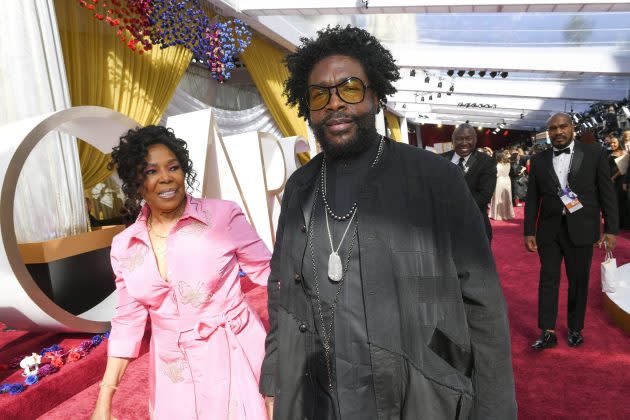
When Gee’s Bend quilting makes its way to the Met Gala — courtesy of a Greg Lauren jacket worn by Questlove — fashion is definitely paying attention.
While the historic quilt work from the small Black community that’s still known to residents as Gee’s Bend (though it’s officially Boykin, Alabama) has been tradition since the 19th century, a wave of recent brand collaborations has brought the rural community to the runway.
More from WWD
With Greg Lauren, pieces created in partnership with quilters from Gee’s Bend found their way into retail installations at Bergdorf Goodman and also to the Oscars (again worn by Questlove; the American musician has been a recent and prominent supporter of the wearable works of art). With Chloé, they were part of the fall 2022 Paris Fashion Week shows.
But before more brands — which have already come knocking — decide they want a piece of the Gee’s Bend quilted fashion pie, it’s worth probing how well these tie ups are serving the artisan community.
So far, though things are largely going well, according to some of the quilters, there’s more that could be done when it comes to transparency and the longer-term economic viability of some of these partnerships.
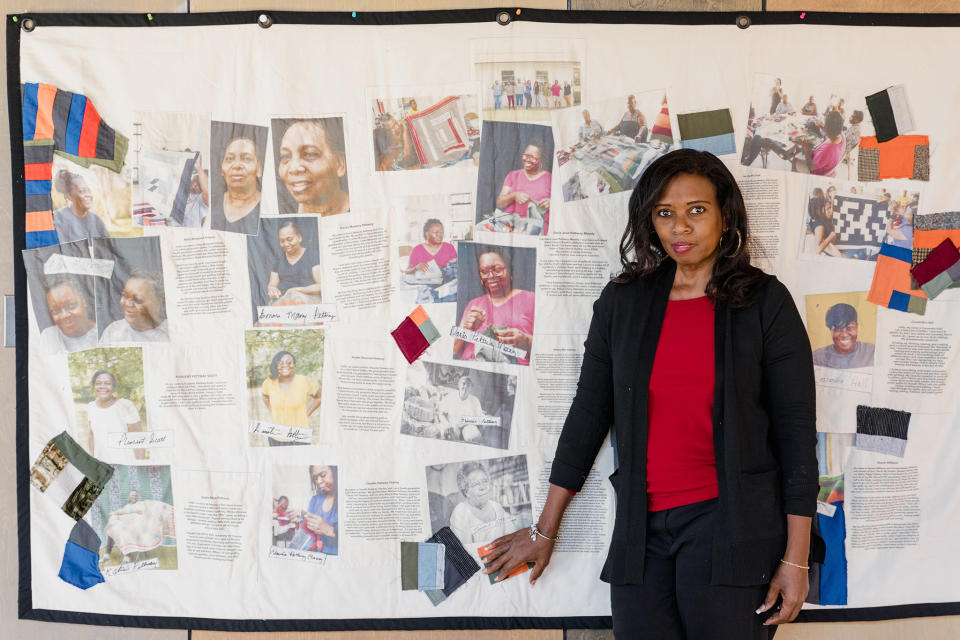
Stacy K Allen
For Claudia Charley Pettway, a fourth-generation Gee’s Bend quilter who holds the surname of many in the community who are descendants of the formerly enslaved people of Pettway Plantation, recognition in the world of luxury fashion has been “surprising.”
“You think about your quilts as a form of survival being a little girl growing up in Gee’s Bend, it was about being warm through the cold winter months,” she told WWD. “So to have the fashion industry take notice — it’s unbelievable. I love every aspect of it, but we’re still learning.”
The Greg Lauren partnership tested the quilters’ long history of working mostly with cotton when the designer sent, in his own words, “everything from nylon to velvets to suiting to menswear fabrics” for their first collaborative collection. But what that partnership is also doing, according to Pettway, is proving a positive way for fashion to work with the community.
“The relationship with Greg Lauren is an ongoing relationship so it’s not a one-and-done type of thing, so I can appreciate and respect that fact. And in saying that, that gives us an opportunity to make more finances for the quilters and the community.”
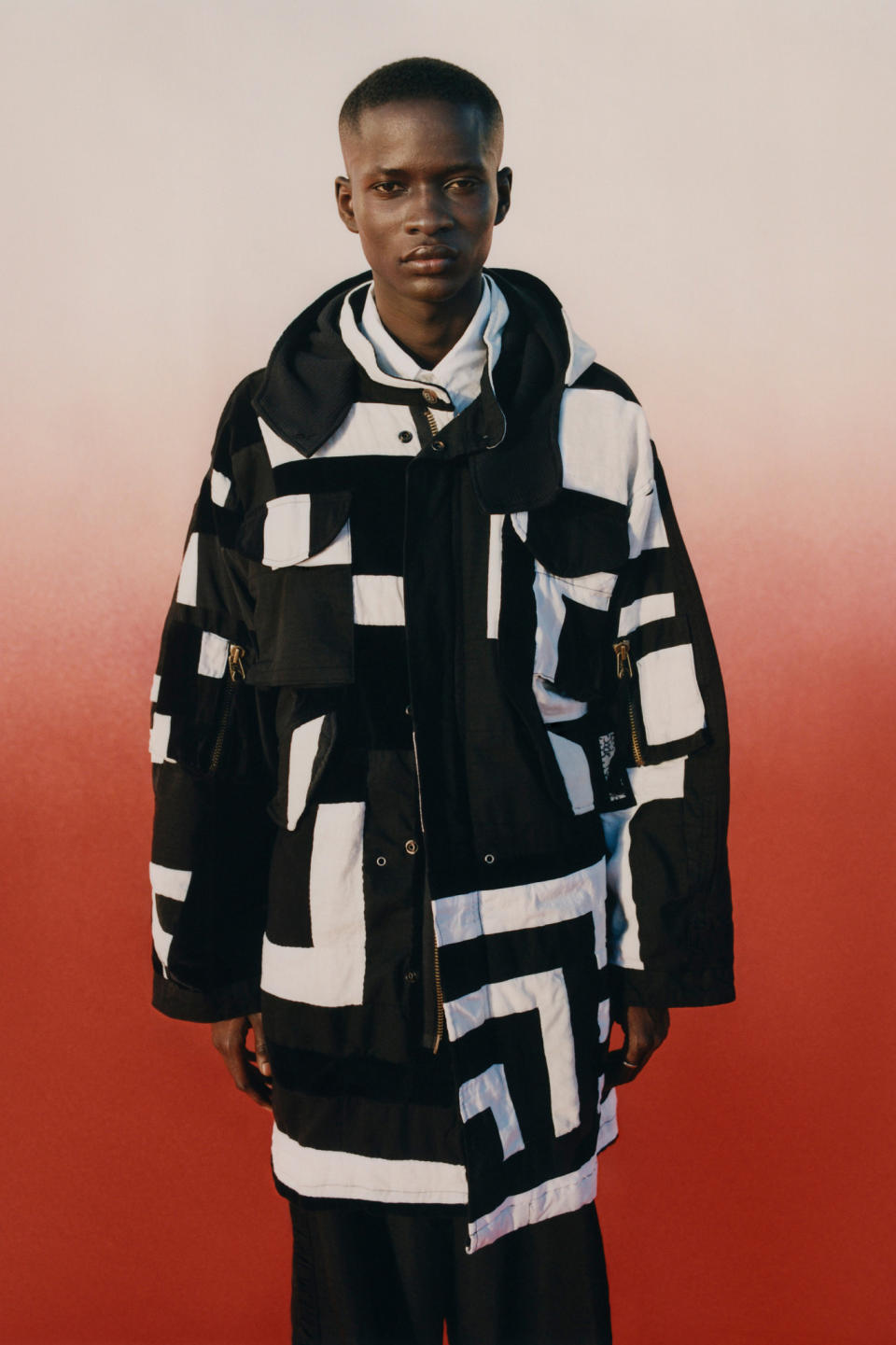
Courtesy of Greg Lauren
With Lauren — who says he’s been committed to making this relationship “an equitable collaboration that really centered on the women, the artists and their artwork” since the start — he and his team started by asking the quilters what they wanted from the partnership. They then settled on three goals that have been the guideposts for the collab so far: create revenue, provide proper recognition for the community and create a model that others in the industry could follow.
It starts with a conversation with the quilters about the project and what they could make together. (In discussing creative direction, Lauren said he told the quilters: “The only creative direction I can tell you is to do the work that you’ve always been doing. And just be you. Just work from that place that you have always worked from because this is celebrating that creative spirit.”)
To make a jacket as they did for Questlove, the quilters and Lauren agree on the price they’ll be paid to quilt panel pieces, which the Greg Lauren team will then use to create the jacket that features each participating quilter’s name sewn into the lining. (“It’s just another way that Greg had of letting people know he was using the work of the quilters and not taking full credit for everything,” Stella Mae Pettway, who worked on one of the Questlove jackets, said.) The money for the panels goes directly to the quilter who makes it.
And Claudia Charley Pettway says the price is fair.
“If we made a piece the size of some of the panels that he asks us to make and we just sewed that piece, more likely sometimes we’re going to sell it for much less — especially the smaller pieces — than what he pays us,” she said.
Over the course of reporting, Greg Lauren made an additional donation of $25,000 to the community using proceeds from the collaborative pieces. Those funds, according to Nest, the nonprofit artisan guild working with the Gee’s Bend community as somewhat of an agent, will go toward supporting “community activities.”
Nest facilitated the partnership with Lauren, bringing the quilters the proposed collaboration and helping them agree on terms for working with the brand and understand the methodology behind what would constitute fair pay for the work at hand.
“We have had brands contact us and…a lot of people wanted to ‘tell [the Gee’s Bend quilters’] story’ without necessarily engaging them in new production or providing economic development for them. So a lot of what we focused on is really helping the Bend navigate those relationships and ensure that they can push back when they want to and keep their best interest at heart and make sure that brands and retailers don’t take advantage of the situation,” Nest founder and executive director Rebecca van Bergen explained. “Eventually we probably won’t be involved anymore but I think sometimes a third party that can help the quilters push back if they’re unhappy with something and review contracts and play that role is sometimes helpful for them. So we’ll always be an adviser and support them even as they take over the strategy independently in the months and years to come.”
Nest said it doesn’t take any funds from the quilters for the representation or any proceeds from the sales of their collaborative projects, but it does receive and manage funds in some cases, like the recent Lauren donation, on the quilters’ behalf.
The partnership with Chloé also came courtesy of help from Nest.
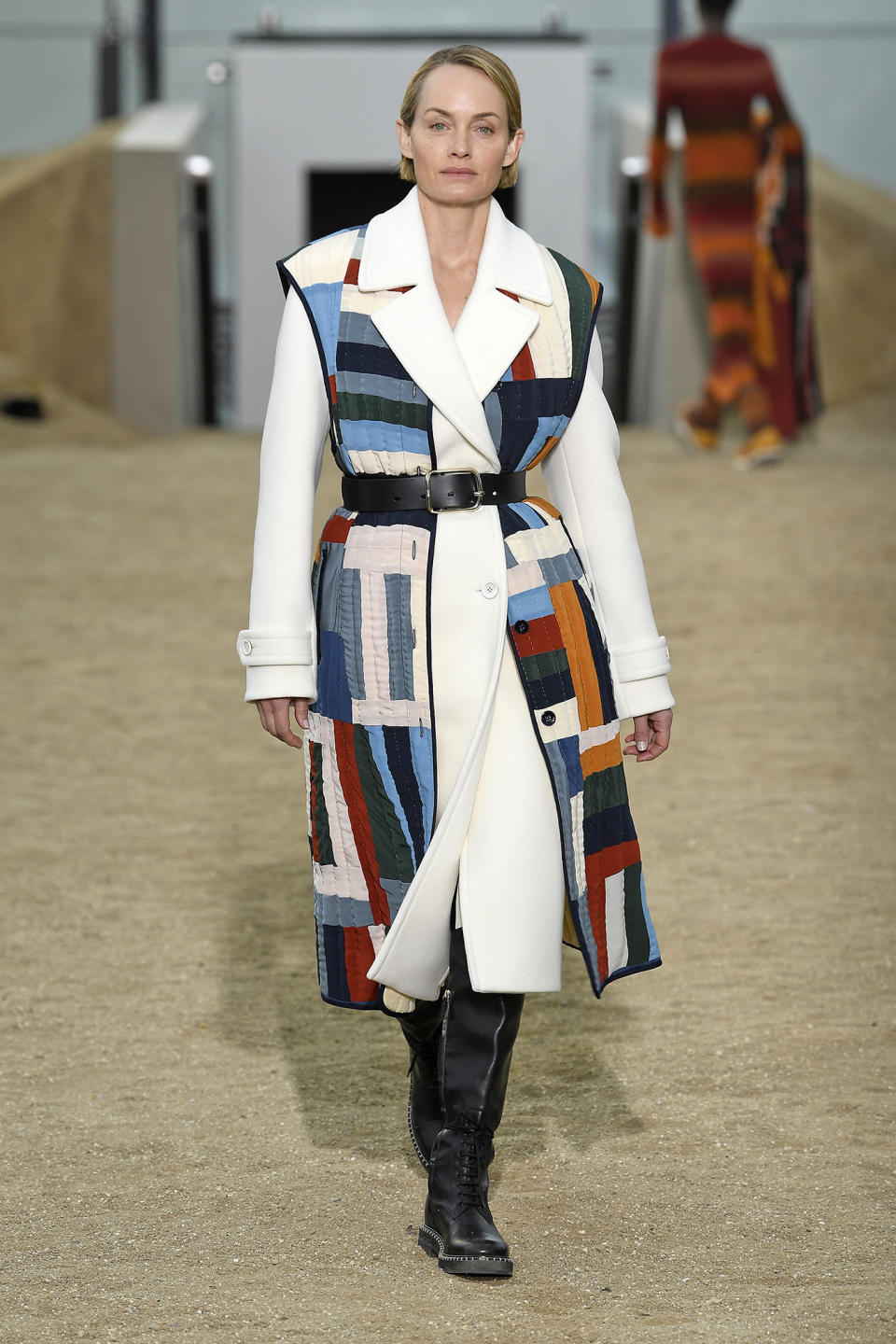
Giovanni Giannoni/WWD
Similarly, the quilters were paid directly (and, admittedly, also fairly) for the pieces they made using deadstock fabric from the French brand, though there was no knowledge among the quilters involved as to whether there were — or would be — any additional funds paid from proceeds of the sales. Creative freedom was also more limited as Chloé had a clear storyboard for the quilters to follow, “but at the same time it was still a great project,” Mary Margaret Pettway, one of the quilters who participated in both the Greg Lauren and Chloé projects, said.
Chloé declined to participate in this story, instead pointing back to its original press release on the collaboration, which notes the compelling Gee’s Bend story, but does not speak to any partnership beyond the product. The quilters did say, however, that Chloé has expressed interest in working together on another round of pieces, extending the collaboration beyond the single season.
But some of the quilters believe they could benefit from more funding, and more autonomy when it comes to collaborations with the fashion industry.
“If they do sell a piece, it would be lovely for them to give us 5 percent of the value of the sale, it would not hurt,” Mary Margaret Pettway said, speaking broadly of the way fashion tie-ups could work for the community. “I know that it’s their ideas, they’re putting up everything basically, they’re giving us what we need to work with, but also the panels are our ideas, and I think that is worth something. So, yeah, 5 percent after they sell it would not be bad at all.” (Note, Pettway’s comment came ahead of Lauren’s additional contribution which does, indeed, constitute more than 5 percent of the value of sales made on the collaborative pieces, though that is only the case for one partner brand thus far).
While credit in the form of name recognition for the work they’re doing has been welcome, Mary Margaret Pettway said there’s no harm in giving the additional financial credit.
“They gave us the credit and recognition, but what’s wrong with giving it again? It’s not like we’re a rich community, we’re far from rich. [Gee’s Bend is a] small, rural, wooded area, we got a couple of stop signs, no stop lights, the nearest store is like 12 miles away, everybody having to drive so yeah, we’re poor, poor and we grew up and it was worse then than it is now,” she said. “So yeah, it would not hurt. They can even call it an investment into this community, that would be fine, because it would make our lives a little bit easier, and they’d be surprised at the return that they’d get if they did do it.”
For now, most investments into the community — beyond payment for apparel-destined panels that go directly to the quilters or what individual quilters make from sales through their Etsy shops — are either being facilitated by Nest or Souls Grown Deep, the nonprofit that has been working with Gee’s Bend the longest and that has been responsible for the high-profile placement of the community’s antique quilts in places like The Met and The Studio Museum in Harlem.
Souls Grown Deep, according to Scott Browning, the foundation’s director of collections, was “gifted” a collection of “about 1,300 objects, works of art, from 160 Black artists all throughout the American Southeast,” including a sizable collection of Gee’s Bend quilts. The quilts had been purchased over the years by collector Bill Arnett who, because he organized the initial Gee’s Bend exhibition at the Museum of Fine Arts in Houston in 2002, has been credited with “discovering” the quilting community.
According to Browning, Souls Grown Deep’s original mandate was “working to advance the art historical legacy of Gee’s Bend and work to have it included in the canon of American art history,” and the organization has since then both sold and donated works to various museums and institutions, proceeds from which it facilitates entirely.
As the quilters’ notoriety ramped up, Browning said Souls Grown Deep pivoted because it “became an untenable spot for us to be in, being in a very privileged position of being responsible in some way for a great deal of the cultural legacy of that community just by virtue of our collection. But it felt untenable to have that responsibility without bringing with it a [socioeconomic] responsibility to the artists that were still living and ultimately the community that gave rise to that art in the first place.”
That led to the founding of what Souls Grown Deep calls a community partnership, which Browning said “is just a means of trying to see that that value and those resources ultimately get returned back to the community and to the people who were responsible for creating that value in the first place but who historically have not been in a position to benefit directly from it.”
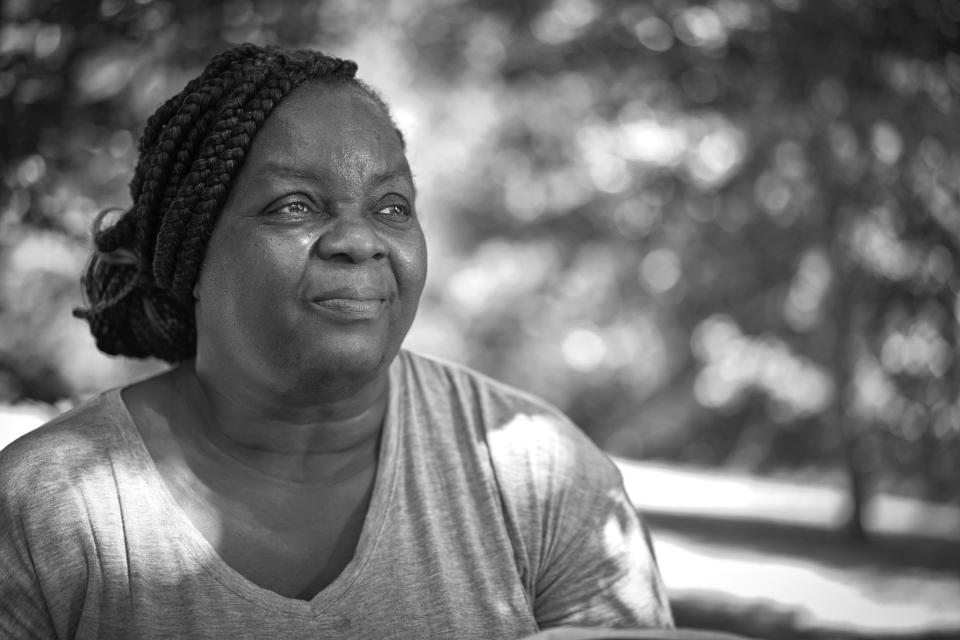
Steve Pitkin
But with the exception of an underwritten Gee’s Bend community manager role, which is held by Claudia Charley Pettway, most of the funds floating around still don’t quite go directly to the quilters.
“So, of that money, a portion of it has to go to simply the operations of the foundation itself, which are things like collections care and management, the storage of the collection, our ability to continue to operate the collection transfer program and to be working with museums,” Browning said. “And then also a portion of that supports an internship program we have that puts undergraduate students of color into museums with whom we partner. Of that then the foundation functions as a support organization to the community partnership, essentially supporting and helping to underwrite all its collaborative efforts working in communities like Gee’s Bend. It also takes the form of things like a $250,000 grant we made to the Freedom Quilting Bee legacy [which will support the renovation of the historic building once home to the Black women’s sewing collective born during Civil Rights as a way for the craftswomen to generate income, and which some of the Gee’s Bend quilters still belong to. The aim is for it to ultimately function as a museum and gallery space to tell of the community’s legacy.]”
Some of Souls Grown Deep’s acquired funds also went to an investment in Pashko, the brand designed by Patrick Robinson, who took a different approach in bringing fashion to Gee’s Bend by actually creating manufacturing jobs for those in and around the community. With regard to Pashko and Robinson, as Claudia Charley Pettway noted, “A lot of the people who came were not African American that presented things to us, so for him to be one of the first, I think that that was really a good thing. I think the fact that he offered long-time job security by being a part of the community and actually having a place where people could come to and actually have a 9 to 5, that was also different because we had never had that before.”
Beyond Pashko, roughly $100,000 of Souls Grown Deep’s funds, according to Browning, went to Nest — which Souls Grown Deep introduced to the quilters — “to facilitate market access” initiatives, like helping the quilters establish Etsy shops (and Nest said Etsy also made a philanthropic contribution to that effort) and get high-quality photographs of their for-sale quilts.
“There are ways that we do try to directly support individual quilters. We instituted a resale royalty act, which is something that much of the world outside the United States has a version of. And what it provides for is when an artist sells a work and the work subsequently resells and presumably at a higher price, the artist is in a position to realize a return or a percentage of that resale,” Browning said. “We’ve been supporting a resale royalty bill along with Artists Rights Society in the Congress. It has not yet passed but we figured just because Congress doesn’t think it’s a good idea, we do, [and] we can [still] do it. So we inaugurated a resale royalty program that provides 5 percent of the funds that Souls Grown Deep returns or receives through the sale of work and returns it to the artists.”
What the quilters don’t have and haven’t seen the funds for, is a building to do their work from.
“I would like to see that we can get a building. If we had a plot of land, I would like to see a building put up on it that we can have somewhere to go, call for meetings,” Stella Mae Pettway said. “When time for a meeting we would have somewhere to go, we won’t have to go calling looking for a key or sit and wait in the back trying to clean up a little space to sit. We would have that place already set and we wouldn’t have to go borrowing tables or chairs or anything like that.”
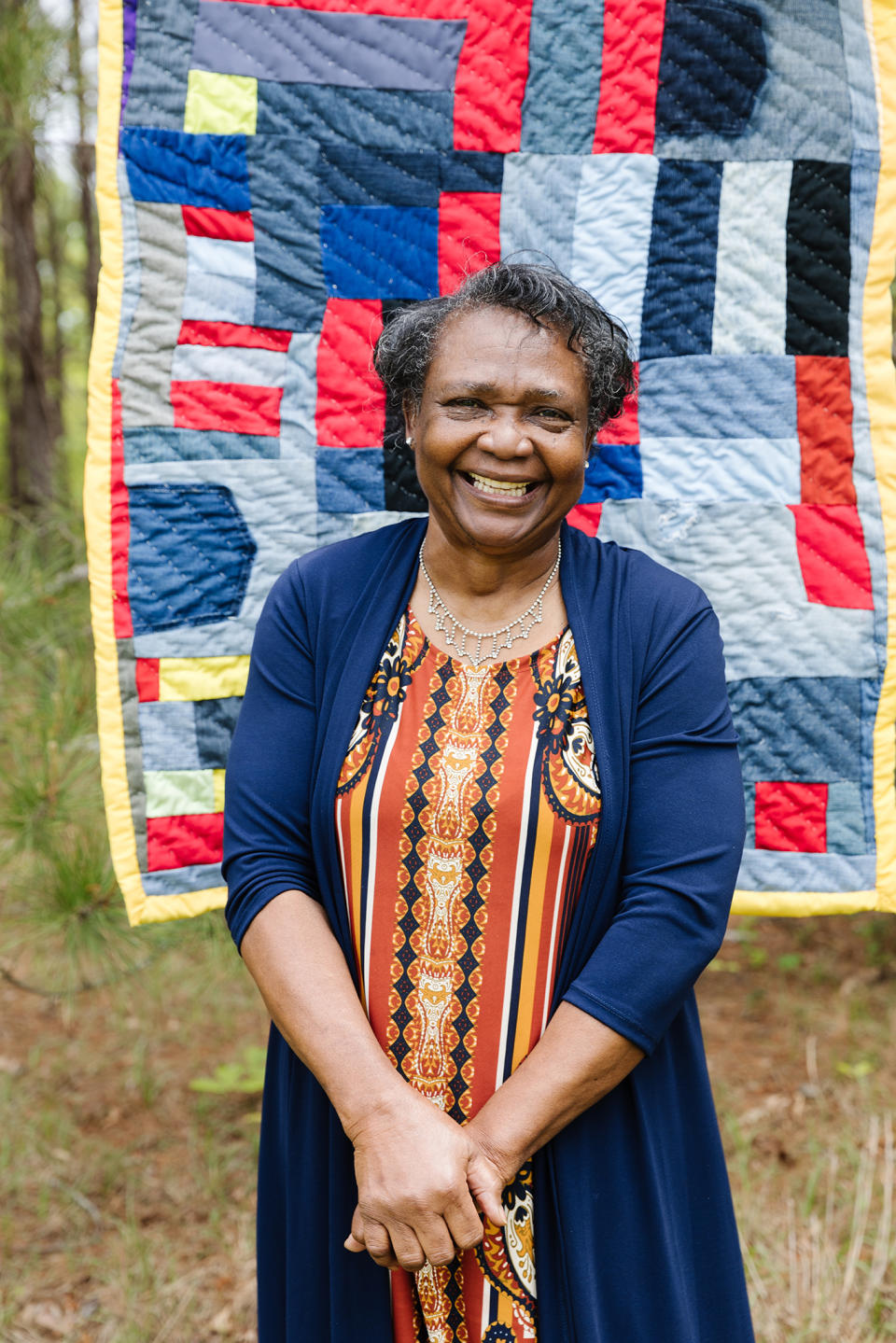
Stacy K. Allen
As Lauren said, “I hope that’s exactly what something like the contribution we’re about to make would go toward. That’s what I was led to believe and understand.”
Nest said the quilters will ultimately decide, though the nonprofit will be facilitating that decision since it’s the one holding the funds.
“We’ve opened up a community projects fund, so we really want the quilters who have participated in the projects who are getting this donation to be able to vote in terms of what’s the most important to them,” said Nest’s director of strategy and sourcing, Amanda Lee. “And that building has come up a lot…but also there’s a general store, more general community projects that are also top of mind for some of them. So we’ll have them decide but we definitely have an ongoing running list.”
Though there’s more to be done, and greater transparency that could be afforded around the passage of money, Claudia Charley Pettway stressed that, “For the first time we’re actually receiving from our labor. Because there have been many times we’ve received nothing and now we get to make some choices and decisions about what we want to do instead of people coming in and telling us what to do…
“I know that for me, being able to receive the extra income, I have a daughter who’s in college so I’m able to actually take some of the money from these collaborations and pay her tuition, so it allows me to not have to depend on things like student loans, which I hate student loans. That’s one of the things that I’ve seen and have experienced as far as the extra finances coming into my household, being able to catch up on bills and at the same time doing the things that I love to do which is the quilting,” she added, crediting both Nest and Souls Grown Deep for what they have been able to do for the community thus far.
Ultimately, what she would want from new fashion partnerships going forward is more autonomy for the quilters of Gee’s Bend.
“It would be great to be able to have our own contracts, negotiate our own deals and then actually put it into action, that’s something that I would love to see in the future,” Claudia Charley Pettway said. “I think this particular era right now is giving us practice for what could come and it’s also making us more confident in the fact that if we can do it for someone else, we can definitely do it for ourselves, independent of anything else…Anybody that’s interested in some type of licensing deal with Gee’s Bend, we are more than happy to discuss that at the table and it does not have to go through any organization. It can be direct.”
Either way, the Gee’s Bend legacy isn’t going anywhere, irrespective of what happens with fashion.
“They left us in the bend of the Alabama River with only one way in and one way out, unless you could swim the Alabama River. When they took the ferry away years and years ago, we were forgotten about. [Ferry service was halted in 1962, allegedly as an attempt to make it more difficult for residents to travel to the county seat of Camden to register to vote, and it wasn’t restored until 2006.]
“So, the only thing we had to depend on was ourselves and the good Lord and from that we used what we had. And out of the dust and the mucky mile and all of that, the farming because we live from the land, everything’s either hunting and fishing and quilting, that’s all we did. And to think about that type of lifestyle and to have something so beautiful, according to the world, that comes out of it, I think that’s the story,” Claudia Charley Pettway said. “We don’t want quilting to be a dying art, and especially with the popularity of Gee’s Bend brand, there is absolutely no way any of us, the way it’s going, could ever stop quilting because everybody keep calling, everybody keep coming, everybody keep wanting to know what’s the next thing for Gee’s Bend.”
Best of WWD
Sign up for WWD's Newsletter. For the latest news, follow us on Twitter, Facebook, and Instagram.
